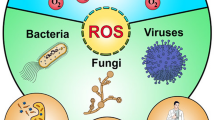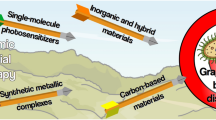Abstract
Despite major advances in medicine in the last 100 years, microbiologically-based diseases continue to present enormous global health problems. New approaches that are effective, affordable and widely applicable and that are not susceptible to resistance are urgently needed. The photodynamic approach is known to meet at least some of these criteria and, with the creation and testing of new photosensitisers, may develop to meet all of them. The approach, involving the combination of light and a photosensitising drug, is currently being applied to the treatment of diseases caused by bacteria, yeasts, viruses and parasites, as well as to sterilisation of blood and other products.
Similar content being viewed by others
References
O. Tunger, G. Dinc, B. Ozbakkaloglu, C. Atman and U. Algun, Evaluation of rational antibiotic use, Int. J. Antimicrob. Agents, 2000, 15, 131–135.
P. Grellier, E. Mouray, V. Agmon, J. C. Maziére, D. Rigomier, A. Dagan, S. Gatt and J. Schrevel, Photosensisitised inactivation of Plasmodium falciparum and Babesia olivergens — infected erythrocytes in whole blood by lipophilic pheophorbide derivatives, Vox Sang., 1997, 72, 211–220.
M. Wainwright, Photodynamic antimicrobial chemotherapy, J. Antimicrob. Chemother., 1998, 42, 13–28.
Z. Malik, J. Hanania and Y. Nitzan, Bactericidal effects of photoactivated porphyrins: an alternative approach to antimicrobial drugs, J. Photochem. Photobiol., B: Biol., 1990, 5, 281–293.
M. Ochsner, Photophysical and photobiological properties in photodynamic therapy of tumours, J. Photochem. Photobiol., B: Biol., 1997, 39, 1–18.
T. J. Dougherty, C. J. Gomer, B. W. Henderson, G. Jori, D. Kessel, M. Korbelik, J. Moan and Q. Peng, Photodynamic therapy: a review, J. Natl. Cancer Inst., 1998, 80, 889–902.
G. Bertoloni, F. Rossi, G. Valduga, G. Jori, H. Ali and J. van Lier, Photosensitising activity of water- and lipid-soluble phthalocyanines on prokaryotic and eukaryotic microbial cells, Microbios, 1992, 71, 33–46.
H. Nikaido, Permeability of the lipid domains of bacterial membranes, in Membrane transport and Information Storage, ed. R. C. Aloia, C. V. C. Curatin and L. M. Gordon, Alan R. Liss, New York, 1990, pp. 165–190.
Z. Malik, H. Ladan and Y. Nitzan, Photodynamic inactivation of Gram-negative bacteria: problems and possible solutions, J. Photochem. Photobiol., B: Biol., 1992, 14, 261–266.
M. Merchat, G. Bertoloni, P. Giacomoni, A. Villanueva and G. Jori, Meso-substituted cationic porphyrins as efficient photosensitisers of Gram-positive and Gram-negative bacteria, J. Photochem. Photobiol., B: Biol., 1996, 32, 153–157.
A. Minnock, D. I. Vernon, J. Schofield, J. Griffiths, J. H. Parish and S. T. Brown, Photoinactivation of bacteria. Use of a cationic water-soluble zinc-phthalocyanine to photoinactivate both Gram-negative and Gram-positive bacteria, J. Photochem. Photobiol., B: Biol., 1996, 32, 159–164.
N. S. Soukos, M. R. Hamblin and T. Hasan, The effect of charge on cellular uptake and phototoxicity of poly-lysine chlorin e6 conjugates, Photochem. Photobiol., 1997, 65, 723–729.
G. Bertoloni, A. Viel, A. Grossato and G. Jori, The photosensitising activity of haematoporphyrin on mollicutes, J. Gen. Microbiol., 1985, 131, 2217–2223.
G. Bertoloni, E. Reddi, M. Gatta, C. Burlini and G. Jori, Factors influencing the haematoporphyrin-sensitised photoinactivation of Candida albicans, J. Gen. Microbiol., 1989, 135, 957–966.
V. Carré, O. Gaud, I. Sylvain, O. Bourdon, M. Spiro, J. Blais, R. Granet, P. Krausz and M. Guilloton, Fungicidal properties of meso-arylglycosyl-porphyrins: influence of the sugar substituents on photoinduced damage in the yeast Saccharomyces cerevisiae, Photochem. Photobiol., 1999, 48, 57–62.
K. Kassab, T. Ben Amor, G. Jori and O. Coppellotti, Photosensitisation of Colpoda inflata by meso-substituted cationic porphyrins, Photochem. Photobiol. Sci., 2002, 1, 560–564.
O. R. Anderson, Comparative Protozoology, Ecology, Physiology, Life History, Springer Verlag, Berlin, 1988.
A. Wagner, Water resource management in an interdisciplinary perspective, in Euro-Mediterranean Sciences and Technology Cooperation, ed. M. Kayamanidou, Ballière Tindall, London, 1997, pp. 44–46.
S. Lustigman and E. Berthus, Photosensitised inactivation of Plasmodium falciparum in human red cells by phthalocyanines, Transfusion, 1996, 28, 643–648.
K. Kassab, D. Dei, G. Roncucci, G. Jori and O. Coppellotti, Phthalocyanine-photosensitised inactivation of a pathogenic protozoan, Acanthamoeba palesteninensis, Photochem. Photobiol. Sci., 2003, 2, 668–672.
Z. Alouini and M. Jemli, Porphyrin photodisinfection of secondary waste water, J. Environ. Monit., 2001, 41, 429–435.
Author information
Authors and Affiliations
Rights and permissions
About this article
Cite this article
Jori, G., Brown, S.B. Photosensitized inactivation of microorganisms. Photochem Photobiol Sci 3, 403–405 (2004). https://doi.org/10.1039/b311904c
Received:
Accepted:
Published:
Issue Date:
DOI: https://doi.org/10.1039/b311904c




